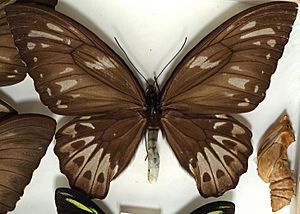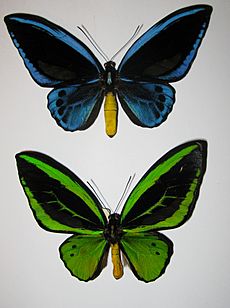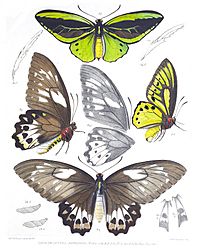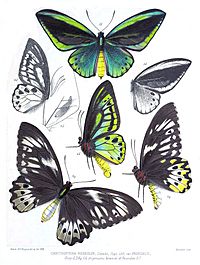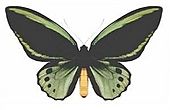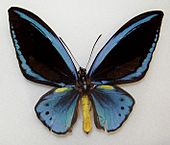Common green birdwing facts for kids
Quick facts for kids Common green birdwing |
|
|---|---|
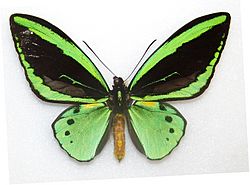 |
|
| O. p. pronomus, male | |
| Scientific classification | |
| Kingdom: | |
| Phylum: | |
| Class: | |
| Order: | |
| Family: | |
| Genus: |
Ornithoptera
|
| Species: |
O. priamus
|
| Binomial name | |
| Ornithoptera priamus (Linnaeus, 1758)
|
|
 |
|
| Distribution of Ornithoptera priamus (in red), with O. p. poseidon (1), O. p. pronomus (2), O. p. macalpinei (3), and other species of Ornithoptera in Australia. Note: range is not limited to Australia. | |
The Ornithoptera priamus, also known as the common green birdwing or Priam's birdwing, is a large and beautiful butterfly. It gets its name from Priam, a king in ancient Greek stories.
You can find this butterfly in many places. It lives in the central and southern Moluccas, New Guinea, the Bismarck Archipelago, the Solomon Islands, and north-east Australia.
Contents
What Does It Look Like?
Ornithoptera priamus butterflies look different depending on if they are male or female. This is called sexual dimorphism.
Male Butterflies
The male butterflies are very striking. Their top forewings are a velvety black. They have bright green stripes along the edges. There is also a green stripe near the front edge of the wing.
The hindwings are mostly green. Near the body, they have yellow-gold spots. There is also a line of black spots further out on the wing. The very edge of the hindwing is black.
The underside of the wings is dark green or bluish. The yellow-gold spots from the top can be seen through the wing. The veins in the wings are partly black.
The body of the male butterfly is yellow. Its head and chest (thorax) are black. The underside of the chest has soft red hairs.
Female Butterflies
Female butterflies are usually bigger than males. Their main color is dark brown. On their forewings, they have a line of white spots.
On their hindwings, they have a line of larger white spots. These spots often have dark centers. The underside of the female's wings looks very similar to the top.
Life Cycle
Like all butterflies, the Ornithoptera priamus goes through different stages. It starts as a larva (caterpillar) and then becomes a pupa before turning into a butterfly.
Larva (Caterpillar)
When they first hatch, the larvae are wine red. They quickly turn black or dark brown. They have soft bumps all over their body. These bumps have stiff, black spines.
On their fourth body part, the bumps are red. On other parts, they are dark brown. As they grow, the bumps lose their spines. The red bumps on the fourth part become lighter.
In later stages, the caterpillar's body becomes grey or brown. The bumps on the fourth body part turn white. Sometimes, there are also white marks on the fifth and sixth body parts. The tips of the bumps are black.
Pupa
The pupa is the stage where the caterpillar changes into a butterfly. The pupa of this butterfly can be yellowish-green or brown. It often has grey lines, which help it blend in like a leaf. This is a type of camouflage.
The pupa has eight pairs of sharp bumps on its belly. These bumps stick out to the sides.
How They Vary
Ornithoptera priamus is a species that can look quite different. The first one ever described came from Seram Island in Indonesia.
Female butterflies are always larger and less colorful than males. They are usually black or dark brown. Their patterns are in pale brown, yellow, or white. However, females can vary a lot in their patterns.
Male butterflies usually have green shiny (iridescent) areas on their wings. But some groups of these butterflies, found on islands east of New Guinea, have blue males. These include O. p. urvilleanus (from New Ireland, Bougainville, and the Solomon Islands), O. p. miokensis (from Mioko Island), and O. p. caelestis (from the Louisiade Archipelago).
Sometimes, O. p. miokensis is thought to be a mix of O. p. urvillianus and O. p. bornemanni. This is because specimens from Mioko Island can look like either parent or a mix of both. Mioko is a small island, and there are not many of their favorite food plants left there.
Some other birdwing butterflies were once thought to be types of O. priamus. These include the O. euphorion and the O. richmondia. Some scientists still think they are types of O. priamus.
Subspecies
A subspecies is a group of animals within a species that has small differences. These differences are often because they live in different places. Many different types of O. priamus have been named over time. Here are some of the recognized subspecies:
- O. p. admiralitatis – found in the Admiralty Islands, Papua New Guinea
- O. p. albiro – found in the Tayandu Islands, Indonesia
- O. p. arruana – found in the Aru Islands, Indonesia
- O. p. aureus – found in the Arfak Mountains of West Papua, Indonesia
- O. p. boisduvali – found in Woodlark Island, Papua New Guinea
- O. p. bornemanni – found in New Britain and nearby islands, Papua New Guinea
- O. p. caelestis – found in the Louisiade Archipelago, Papua New Guinea
- O. p. demophanes – found in the D'Entrecasteaux and Trobriand Islands, Papua New Guinea
- O. p. garainaensis – found near Garaina, Papua New Guinea
- O. p. gebeensis – found in Gebe Island, Indonesia
- O. p. hecuba – found in the Kai Islands, Indonesia
- O. p. impensis – found in Manipa Island, Indonesia
- O. p. kassandra – found in Yapen Island of West Papua, Indonesia
- O. p. macalpinei – found in the Iron and McIlwraith Ranges of Queensland, Australia
- O. p. miokensis – found in Mioko Island, Papua New Guinea
- O. p. poseidon – found in New Guinea and the northern Torres Strait Islands
- O. p. priamus – found in Seram, Saparua and Ambon, Indonesia
- O. p. pronomus – found in the southern Torres Strait Islands of Queensland, Australia
- O. p. sterrensis – found in Mt. Sterren of West Papua, Indonesia
- O. p. teucrus – found in Biak and Supiori of West Papua, Indonesia
- O. p. wituensis – found in the Vitu Islands, Papua New Guinea
- O. p. urvillianus – found in New Ireland and Bougainville, Papua New Guinea, and the Solomon Islands
Protecting This Butterfly
This butterfly species is still found in many places. However, some of its subspecies are in danger. This is mostly because their homes (habitats) are being destroyed. Subspecies that live only on small islands, like O. p. miokensis, are especially at risk.
Like all birdwing butterflies, O. priamus is protected by an agreement called CITES. This means that you need a special permit to move these butterflies across country borders. This helps control trade and protect them.
Gallery
- Selection of museum specimens of Ornithoptera priamus
More Information
- Consortium for the Barcode of Life priamus at Barcode of Life
- Consortium for the Barcode of Life priamus poseidon at Barcode of Life


